Recently, there were lively discussions in online groups about sleeping in mountain bivouacs, and I have jumped into a few myself. This inspired me to create this comprehensive guide for anyone curious about experiencing a night in a bivouac for the first time.

How is it in a bivouac?
You want a short answer? If so, here it is: it is very cold at night no matter the weather and season. This is always so in particular with those alpinist metal containers that are on high elevations, one is shown below, the Bivacco Suringar.
However, during the day, it may be very different if it is sunny. If the bivouac is made of wood, occasionally, you will hear cracks as the wood heats by the sun and expands. In such situations, the inner is very pleasant, and you will love to be inside.

Though, regarding cold, there are exceptions, I was really pleasant and warm with the fire on when I was in Bivak za Akom in the Slovenian Alps. This is again a typical metal-shell container, very old but with wood inner walls, but with a wood burning stove.

In general, it is far better in bivouacs of any kind that have a wood burning stove, and these are typically on lower elevations and below the tree line.
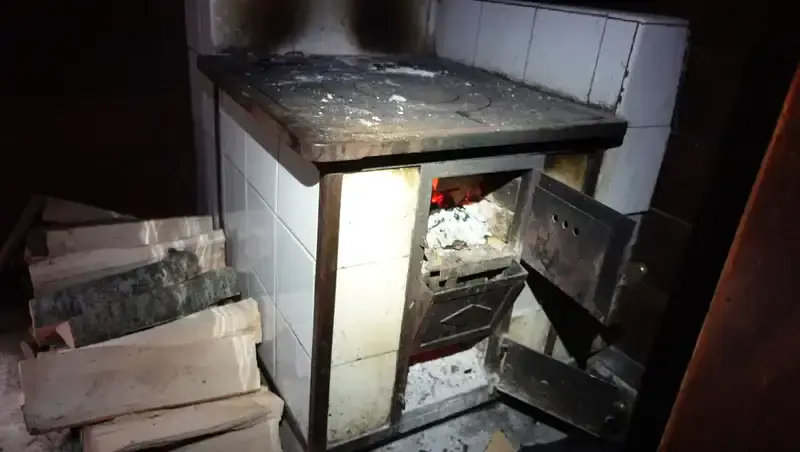
Though there are some where you have a wood burning stove even at much higher elevations. Some of them get wood by helicopters.
One typical example, where I spent a night long ago, is the Igloo des Pantalons Blancs in Swiss Alps, the top picture above is from it. Here, I must admit, it was warm and cozy, a great night in solitude at 3280 meters of elevation.
In some situations, on your way up you will get to the spot where wood is ready and prepared for the bivouac, so you may want to carry some up to the bivouac. I have seen it on my tour to Bivacco Latemar, and and also in Lagorai area.
In some bivouacs you can have an open-fire place on the floor, without a stove, and you cook by hanging a pot above the fire. But in some, you can have a beauty of this type, have a look:
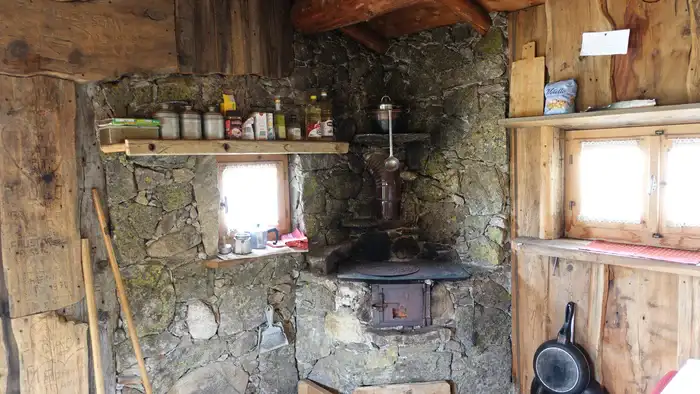
But even when you have fire inside, it may be very hard to make it warm enough, in particular if this is a stone building like the bivouac at Lago del Monte (2606 m) on the route to Monte Breva.
On the other hand, in the wooden Bivacco Battaglione Ortles nothing could make us warm, too high in the mountain and too damp inside.

In some bivouacs with a wood stove you will realize that everything smells on smoke, even if the inner looks new and modern as in the picture below that shows one bivouac above Livigno. Look carefully, you will see somebody sleeping on the platform above the table.
It may smell so much that sometimes I simply have no desire to spend a night inside. But hey, wait and read the next section.

How is it in a bivouac when it rains?
I would start withe the following statement: if you have ever experienced a storm in a mountain bivouac of any kind, then I am sure you have i) learned to appreciate their existence, and, ii) realized the full might of Nature.
In such moments you are able to understand how vulnerable we as humans are. Some of my best moments in the mountains are those with a storm outside and me in a bivouac.
In fact, when I go somewhere overnight, I hope to have a night with rain or storm and then a clear sky in the morning.
But see here what happens when somebody behaves irresponsibly: the door was left open and the bivouac was full of snow at 3340 meters of elevation. I have no words, but see the short video here. It seems this is winter bivouac on Marmolada Punta Penia, looks familiar to me.
Sensitive to snoring?
If the answer here is yes, then make sure you have some good earplugs. There are very good made of silicone or something similar that I use myself all the time.
I remember a funny episode from the Bivacco Val Loga (see the picture below). In the evening, one kind man gave earplugs to everybody, just in case. But I had my own as usual.
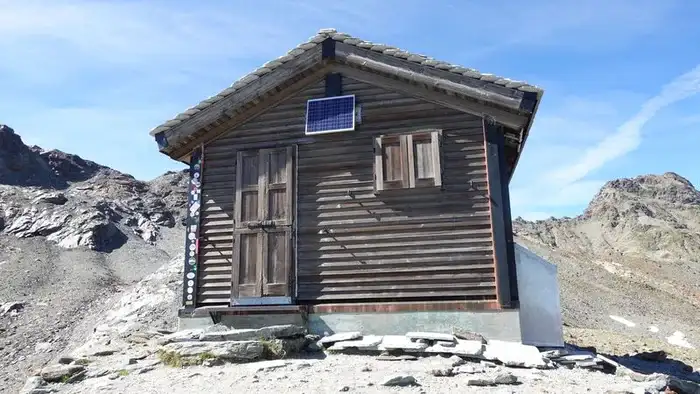
Well, the same good man did not stop snoring all the long night, and he was not the only one. In the morning, he announced “ho dormito bene” (I slept well). I knew he did, but I decided not to say anything about my own sleepless night.
What to do? This is all natural and you cannot blame the person in such situations. But from my own bad experience, I know for sure: somebody will always snore.
So, if you cannot stand this, have a tent with you and sleep outside in particular if there are many people in the bivouac.
How about water in a bivouac?
You have seen the Bivacco Val Loga above, it had a water stream nearby, and there was a water canister in the shelter, so I brough water in.
In many other places, I have seen water containers with rain water collected from the roof, and I used it for dishes and sometimes even for drinking.
However, I would never use any water without passing it through my water filter/purifier. I have another article where this topic is discussed in detail. Here just to mention that there are a few reliable items of that type on the market. I definitely trust MSR and can fully recommend it.
In some places you can use snow and ice and melt for cooking and drinking. This is what I did at the mentioned Igloo des Pantalons Blancs and Bivacco Battaglione Ortles, see the picture.
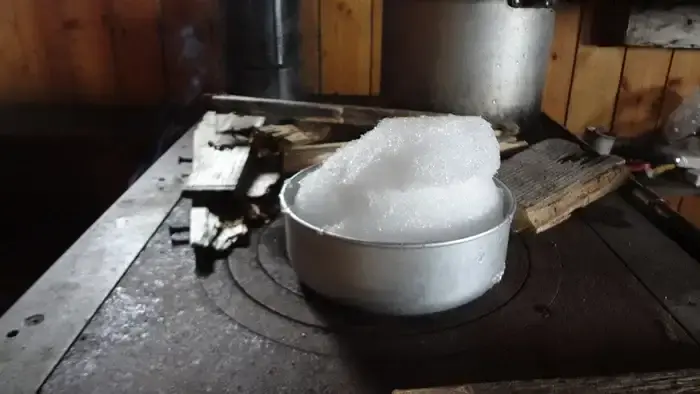
Do you need a sleeping pad in a bivouac?
In many of them you will have mattresses in place, for example in alpinist bivouacs in the Italian Alps they are always available. So you do not need a pad. Here below you can see what to expect in such shelters, mattresses and plenty of blankets:

But make sure that you are informed about your next shelter, and have a sleeping pad with you if necessary.
For example, I have slept in some bivouacs in the Slovenian Alps where there is only a wood platform. Yes, you can manage without a pad even here, but it will not be very comfortable.

However, in some bivouacs you have nothing available, so you have to sleep on the floor, or on the table, or on benches. I have seen a couple of them in Livigno area (one shown in the pictures below), and also in the Dolomites.
Is it clean in a bivouac?
I must say that from my experience, bivouacs are usually surprisingly clean regarding thrash, people tend to carry their garbage with them.
Have a look on the pictures below, the first is inside Bivacco Barraca degli Alpini below the summit of Tofana di Dentro. It is clean inside, though everything is old here. But it looks better inside than outside, see the second picture:
You understand that some of them have been there for decades, so mattrasses, pillows, and blankets may be dirty and they may not smell pleasant.
Many of them are high in the mountains and frequently in clouds, so condensation may be huge and the inner area feels wet, sometimes quite unpleasant. Cooking inside adds to this feeling even more.
You cannot expect that blankets and pillows there are clean in any case. This is why it is a must to have your own sleeping bag with you.
This holds even when you see the situation in the picture below, this is from the beautiful Bivacco Luca Vuerich in the Julian Alps. This is the most pleasant one I have ever seen, built and maintained by a family of a climber who died by an accident in the nearby mountains.
By bringing your own sleeping bag, you help those who maintain such a shelter and keep it up and running for you and for everybody else.

Any health hazards?
Rodents in bivouacs
So, there are possible health hazards issues regarding mice and rats. They can pose health risks due to their potential to carry diseases.
Once, I have seen a video on YouTube when somebody was recording in the bivouac during the night. The camera captured mice walking over tables where people eat without thinking about possible infections.
I missed to save the video link and I regret this, so if by any chance you know it, please let me know.
But see the picture below: this is the door on Bivacco Redolf in the Lagorai area in the Dolomites. There is a hole clearly done by some animals, so no doubt mice, rats or weasels enter the bivouac when there are no people inside, so bear this in mind.
Note that I have a map with all the bivouacs in the Dolomites so you can explore it and plan your trips, the mentioned bivouac is there.

My guess is that it is far more likely that mice find a way to get into wooden and stone shelters than in those metal containers type. The latter are normally completely enclosed and without holes, but I may be wrong.
Now, for this article, I was searching a bit and here is what I have found about key infection possibilities to consider. But I wish to stress that I am a theoretical physicist and not a medical doctor, so let me know in the comments section below if you know more.
Hantavirus pulmonary syndrome: A rare but serious respiratory disease transmitted through contact with mouse urine, droppings, or saliva, or by inhaling dust contaminated with these.
Symptoms include muscle pain, fever, and fatigue, potentially leading to severe breathing difficulties or organ failure if untreated.
Bivouacs, especially in remote areas, may have dust or surfaces contaminated by mice, increasing risk if not properly cleaned.
Leptospirosis: A bacterial infection spread through contact with water, food, or surfaces contaminated by infected mouse urine. Symptoms include fever, headaches, muscle pain, and jaundice, with potential complications like kidney or liver damage.
In a bivouac, uncovered food or water sources could be contaminated by mice foraging at night.
Rat-bite fever: Transmitted through bites, scratches, or contact with mouse saliva. Symptoms include fever, rash, and joint pain. While less likely unless directly bitten, mice climbing on gear or bedding in a bivouac could pose a risk.
Plague: A rare disease spread through flea bites from infected mice or direct contact with their bodily fluids.
Symptoms vary (bubonic, septicemic, or pneumonic forms) and include fever and swollen lymph nodes. Fleas in a bivouac could transfer the bacteria if mice are present.
Salmonellosis: Mice can contaminate food or surfaces with Salmonella bacteria via their droppings, leading to food poisoning with symptoms like diarrhea, fever, and abdominal cramps.
This is a significant risk in bivouacs if food isn’t stored securely.
However, after all this, I tried to find any documented case about infections due to stays in bivouacs, and could not find any.
The only one that looks like a close analogy is the Yosemite hantavirus outbreak (2012) in tent cabins, as these structures share similarities with bivouacs (enclosed, remote, rodent-accessible). Nine cases were reported, with three deaths, linked to deer mice.
My guess is that there may be sporadic infection cases that appear occasionally, but those do not get publicized.
Anyway, to switch from such dark topics, see the beauty of this bivouac:
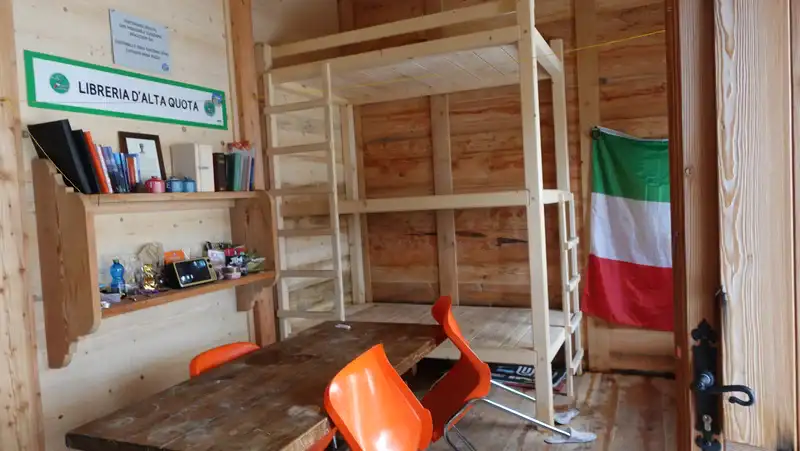
Preventive measures for bivouacs
Secure food and waste: Store food in airtight, rodent-proof containers and dispose of waste properly to avoid attracting mice.
Clean surfaces: Disinfect tables, cooking areas, and sleeping surfaces to remove potential contaminants like droppings or urine. Use gloves when cleaning to avoid direct contact.
Seal entry points: Ensure the bivouac is as sealed as possible (e.g., zip tents tightly, check for holes) to limit mouse access.
Elevate gear: Keep sleeping bags, backpacks, and gear off the ground to reduce the chance of mice climbing onto them.
Inspect for signs: Look for droppings, gnaw marks, or nests before settling in. Mice are nocturnal, so activity is more likely at night, as seen in your video description.
But are there really rats and mice at such high elevations?
Oh yes, you have seen the door above, with the hole in it, and elevation is 2335 meters.
Have a look at the picture below, this is from my tour to Punta degli Spiriti, and you see the trail of a small mammal exactly on the summit at elevation of 3467 m. It lives in the rock on the summit, all the surrounding area is under ice year-round.

But I have seen a mouse with my eyes. Last year, I put the tent at Passo di Sant Antonio, in the place shown in the picture, this was on my tour to Cima delle Nove. The elevation was more than 2400 meters.
As I was unpacking, I noticed a mouse under the rock. So I was worried it could damage my equipment during the night, and I hanged all the stuff under the roof.

Dead flies
If you are the first coming in a season, you may find tons of dead flies in a bivouac. They find shelter there before winter, and then eventually die. So make sure you clean the area, see these people in the video at 5:50 doing this.
From what I can read online, dead flies in mountain bivouacs, especially early in the season, can indeed pose health hazards, though the risks are generally lower than those from rodents like mice.
However, thorough cleaning is advisable to minimize potential issues and ensure a safe, comfortable stay. Health hazards of dead flies in bivouacs are the following:
Bacterial contamination: Flies, even when dead, may carry bacteria like Escherichia coli (E. coli), Salmonella, or Shigella on their bodies from contact with decaying matter, feces, or other unsanitary surfaces before entering the bivouac.
If dead flies contaminate food preparation surfaces, utensils, or water, these pathogens could cause foodborne illnesses, leading to symptoms like diarrhea, nausea, or abdominal cramps.
Risk level: Moderate, especially if flies have been in contact with food or water sources.
Fungal spores or allergens: Dead flies can harbor fungal spores or decompose, releasing particles that may trigger allergic reactions or respiratory irritation in sensitive individuals.
In a confined bivouac, inhaling these particles (e.g., during sweeping or close contact) could cause discomfort, especially for those with asthma or allergies.
Risk level: Low to moderate, depending on the quantity of flies and ventilation.
Attraction of other pests: Dead flies can attract other insects (e.g., ants, beetles) or rodents, which may introduce additional health risks, such as those from mice (e.g., hantavirus, leptospirosis, as mentioned earlier).
A bivouac with accumulated dead flies may signal poor maintenance, increasing the likelihood of other pest activity.
Risk level: Moderate, as it compounds other risks.
Pathogen transmission via contact: While less likely than with live flies, handling dead flies or touching contaminated surfaces (e.g., tables, sleeping platforms) without proper hygiene could transfer pathogens to your hands, food, or gear.
This is a concern in bivouacs where hygiene facilities are limited.
Risk level: Low, but preventable with proper cleaning.
Should dead flies be cleaned thoroughly? Yes, thorough cleaning is recommended to mitigate health risks and improve the bivouac’s usability, especially at the start of the season when dead flies may have accumulated over winter.
What if the bivouac is full?
Bivouacs are typically at high elevations, so imagine walking up with the idea to stay there overnight and you realize it is full. It may be late already, and going back is not an option.
In this case, it is the matter of survival, so you will stay inside no matter what. Outside temperatures in the Alps may be below zero degrees Celsius at elevations above 2500 meters even in mid summer.
You may sleep on the floor, sometimes there is plenty of space, see the picture below with view into Bivacco della Pace.
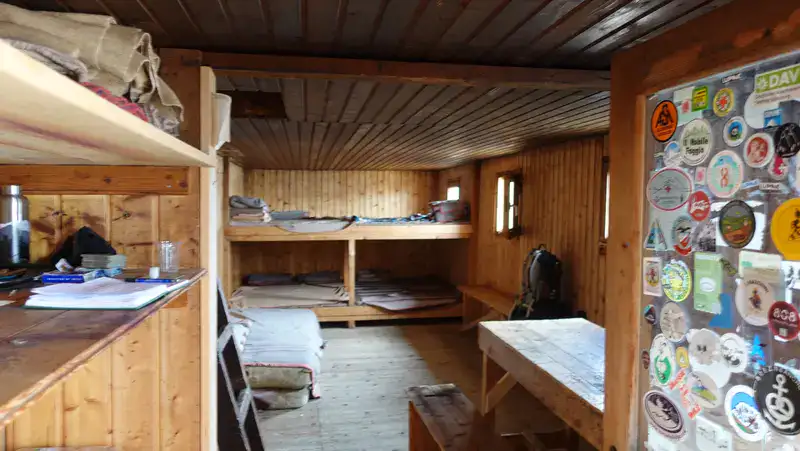
There is always a table and you can sleep on it, or there may be benches inside so put two of them together and make a sleeping platform. If nothing else, sit in the corner and spend the night as you can.
Go home, this is for real alpinists! Really?
Believe it or not, there are comments of that type. I have seen one in a Facebook group.
There is also a video of a person whom I follow on YouTube, who visited Bivacco Fantcon again to see with its own eyes insults that some people wrote about his previous experience in the same bivouac.
So, are bivouacs really only for alpinists?
There are some of them that are at places from where you do not have any marked route up to the mountains. Indeed, these are primarily for people who will climb the rock walls above in true alpinist way. In some cases, there are no marked routes to such shelters.
But if you happen to find yourself in such a place, nobody can tell you to go away, it is as simple as that.
On the other hand, even very typical alpinist-type bivouacs, i.e., those orange, red or yellow metal containers, may be at places where there are no real vertical walls for alpinists. They are for everybody who needs a shelter in such a place, a hiker, a mountaineer, or a hunter.
How about toilets?
Very rarely you will have a simple outhouse close to the bivouac, and this is the best you can expect. I have seen one at Bivak pod Špikom (Bivouac below Spik) in Slovenia, if you follow the link you will see a photo of it.
Yet another example is the Igloo des Pantalons Blancs in Swiss Alps with its well-built outhouse and a ton of feces that, luckily, are frozen all the time due to high elevation, so the stuff does not spread down the mountain.
But people go when they have to go, no matter if an outhouse is available or not. In other words, you can expect that the area around popular bivouacs is quite contaminated.
Think about that next time when you grab the snow next to the bivouac and melt it to use for cooking, or when you refill your bottle in a crystal clear water stream on the way up to such a bivouac.
So never use water directly. Have a filter/purifier with you. I already mentioned above that MSR products are among those that can be trusted.
Is there cooking equipment in bivouacs?
In many of them you will have plenty of stuff, pots, wood burning stove, sometimes with a gas stove as well as in the picture below. But even if they look clean, you can never be sure how people use the things.
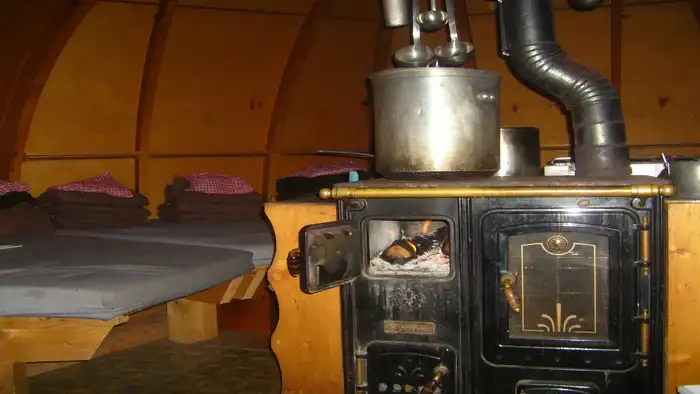
I have seen somebody getting inside only to take a pot, and to put water in it and to give to his dog to drink. Now, I have nothing against dogs, but I do not want to eat from the same pot. Therefore, I carry my own stuff with me.
On the other hand, you have seen the section about mice, so bear this all in mind.
Going alone or not?
Bivouacs are tiny shelters, typically with 4-12 sleeping places. Going solo increases the chance to find a place.
On the other hand, these are remote and lonely places, so having somebody may be more fun. If you are alone, and you happen to share it with a group of people whom you do not know, you may not feel so great.
Are bivouacs free to use?
I have a separate text here in the site on this issue alone, related to the Italian Alps, so please follow the link and read more.
Here just to mention that they are free, but in some of them you may have an option to contribute and put some money in a box on the wall.
Bivouacs are normally always open. But there are a couple of examples known to me where a bivouac is close to a regular hut, and then it may be closed when the hut operates. It is then used only as a winter room or winter shelter.
How to find bivouacs?
In good hiking maps with 1:25000 resolution you will find many of them marked, in particular in Tabacco maps that I use myself. A number of bivouacs in the Alps you will find also in online maps like AllTrails.
In this site, I have created a number of interactive and zoomable maps similar to what you see in the picture below. You can see more if you follow the links to Bivouacs in the Dolomites, in Julian Alps, in Adamello Presanella area, and in Dolomiti di Brenta.
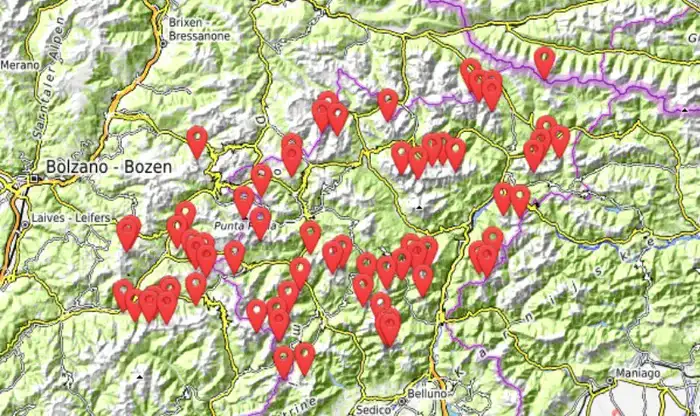
My favorite bivouac?
This is very hard to choose. I have them three now, all very different, no way to decide, have a look:
If you follow the links you may read more and may realize why it is hard to choose, it is about them but also about their locations as well.
• Bivacco Luca Vuerich is on the top of a mountain, and you have seen it inside in one of the pictures in the text above.
• Buffa di Perrero, well, I have no words to describe that place, and I regret for not moving away the plank that you see in its picture, but see the shelter in the video below.
• Bivak pod Špikom (Bivouac below Spik) with its classic shape and elegance, this is a cabin in the Slovenian Alps.
Final thoughts
In summary, sleeping in a mountain bivouac is raw, unpredictable, and perhaps not for everyone. You will face cold nights, snoring strangers, and the occasional mouse or pile of dead flies, each bringing risks.
Clean areas which you touch, secure your food, and always pack a sleeping bag and water purifier.
Some bivouacs, like Bivacco Luca Vuerich, feel welcoming; others, like Bivacco Battaglione Ortles, are damp and unforgiving.
Whether you are an alpinist or a hiker, these shelters are for anyone needing refuge, just don’t expect too much comfort. Go prepared, respect the space, and you will manage, even if it is just surviving the night on a bench.
Please join us at our Facebook group Dolomites Visitors Hub.
Thank you for reading. Please let me know if you have questions, there is a comment box below. I wish you a nice day.

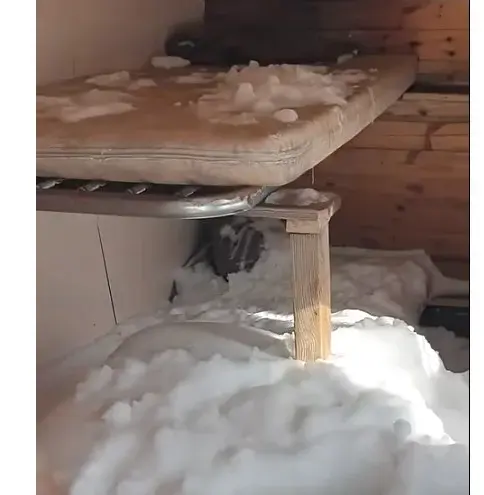
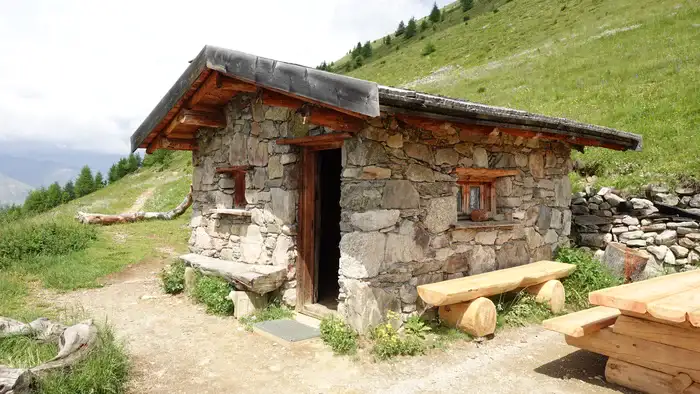
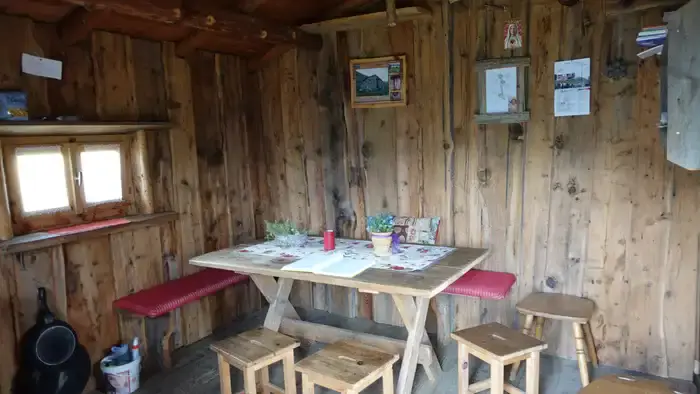


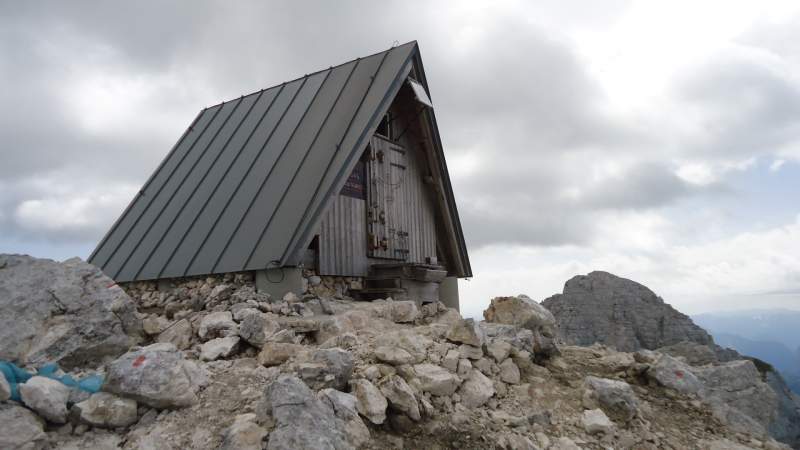
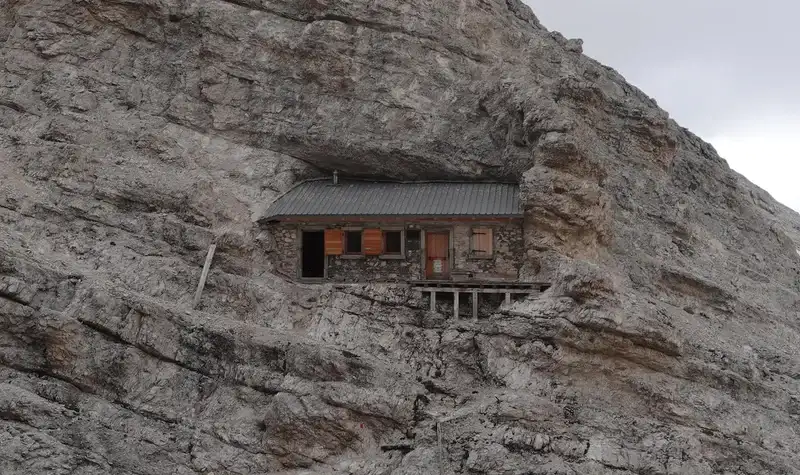
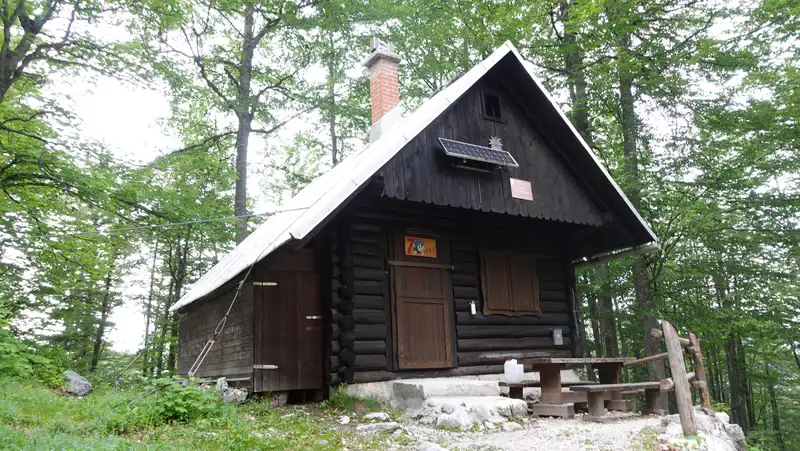
Leave a Reply